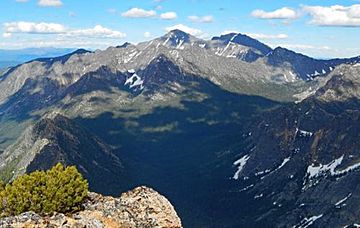North Gardner Mountain facts for kids
Quick facts for kids North Gardner Mountain |
|
|---|---|

Gardner massif
|
|
| Highest point | |
| Elevation | 8,956 ft (2,730 m) |
| Prominence | 3,996 ft (1,218 m) |
| Geography | |
| Location | Okanogan County, Washington, U.S. |
| Parent range | Cascades |
| Topo map | USGS Silver Star Mountain |
North Gardner Mountain is a tall mountain found in the North Cascades area of Washington state. It's located in the Okanogan National Forest. This mountain is the highest point in Okanogan County, Washington, and it's also one of the tallest mountains in the entire state!
How Mountains Formed
The North Cascades are known for their rough and wild look. You can see sharp peaks, tall granite spires, long ridges, and deep valleys carved by glaciers. All these different shapes and heights were created by amazing events that happened millions of years ago. These events also led to different types of weather across the Cascade Range.
The story of how the Cascade Mountains were made began a very long time ago. Around 50 million years ago, the Earth's huge plates were moving. The North American Plate was slowly sliding over the Pacific Plate. This movement caused a lot of volcanic activity. Also, small pieces of the Earth's crust, called terranes, crashed into the land. These collisions helped build up the North Cascades.
Later, during the Pleistocene period, which was over two million years ago, giant sheets of ice called glaciers moved across the land. These glaciers scraped and shaped the landscape many times. As they moved, they left behind piles of rock and dirt. The "U"-shaped valleys you see today were carved out by these powerful glaciers. The combination of the land pushing up (called uplift) and cracks forming in the Earth (called faulting), along with the glaciers, created the tall peaks and deep valleys of the North Cascades.
Mountain Weather
Most of the weather we experience starts over the Pacific Ocean. These weather systems then travel northeast towards the Cascade Range. When these weather fronts reach the North Cascades, the tall mountains force the air to rise. As the air goes higher, it cools down and drops its moisture. This process is called Orographic lift. It causes a lot of rain or snow to fall on the mountains.
Because of this, the west side of the North Cascades gets much more rain and snow than the east side. This is especially true during the winter months. In winter, the weather is usually cloudy. However, in summer, high-pressure systems often form over the Pacific Ocean. These systems bring clear skies, so there is usually little to no cloud cover during the summer months.

